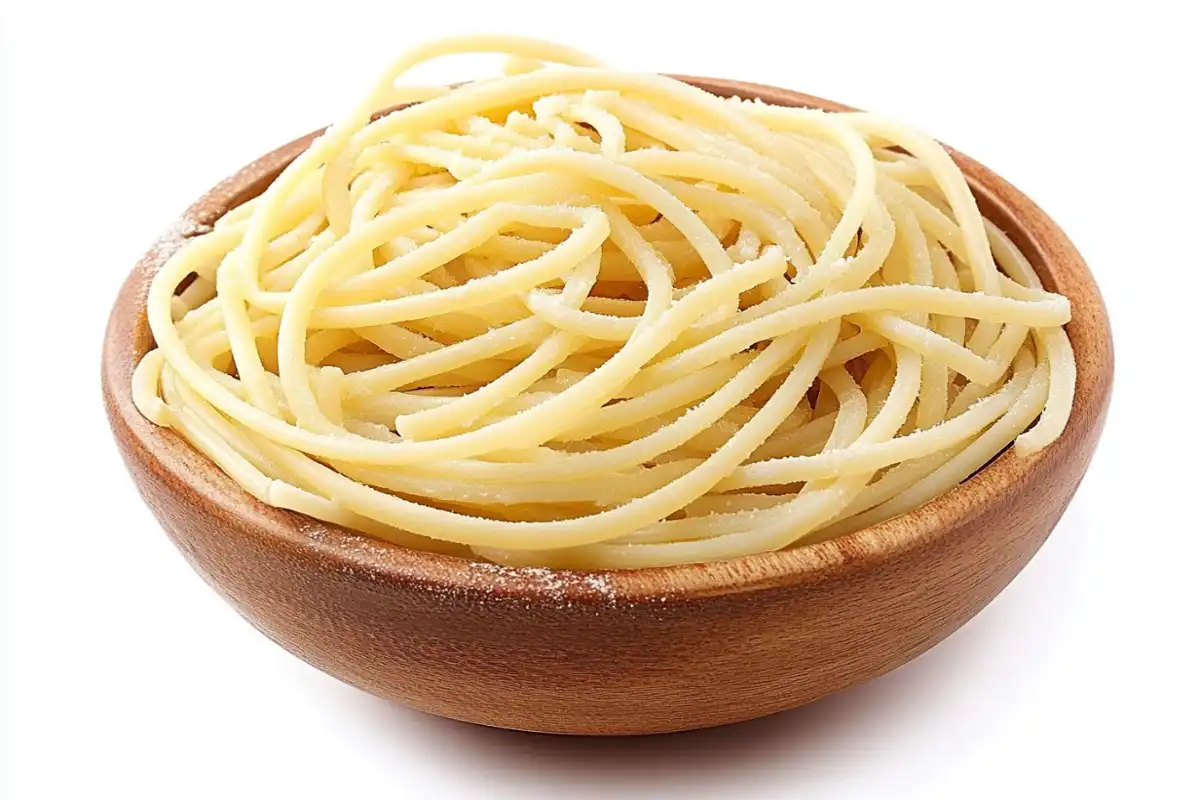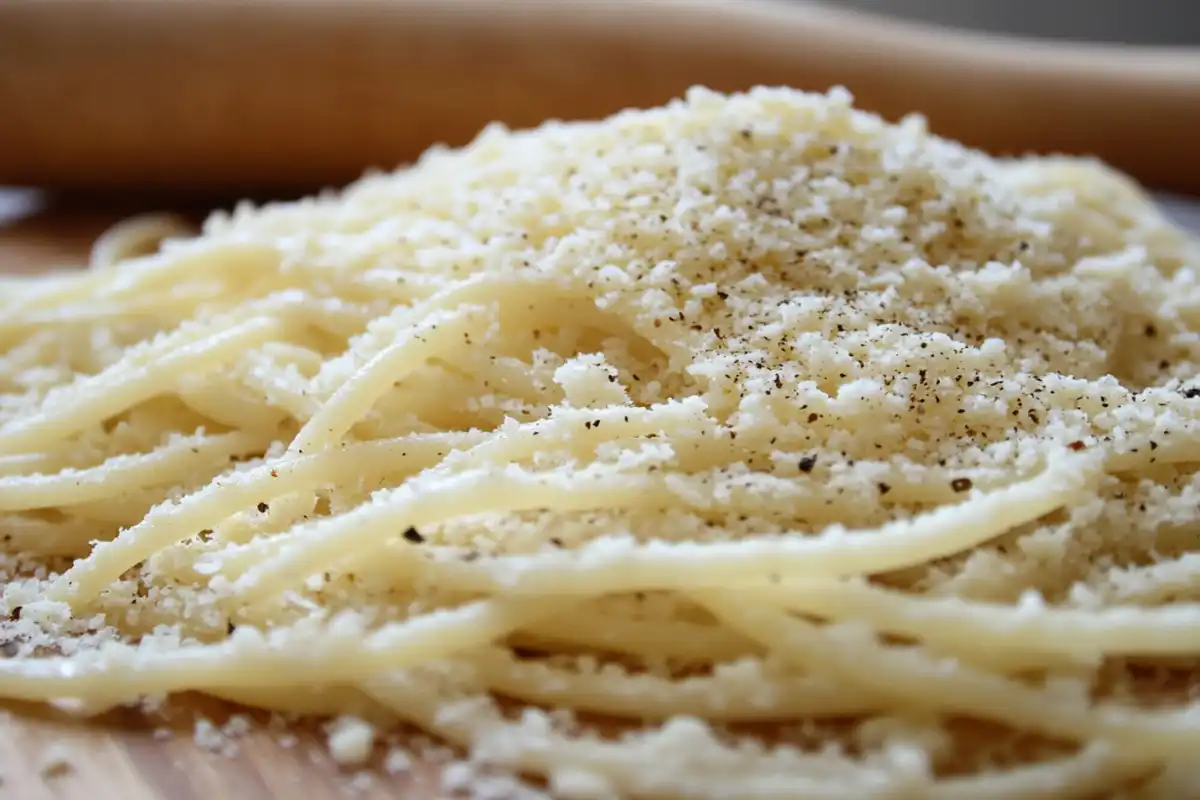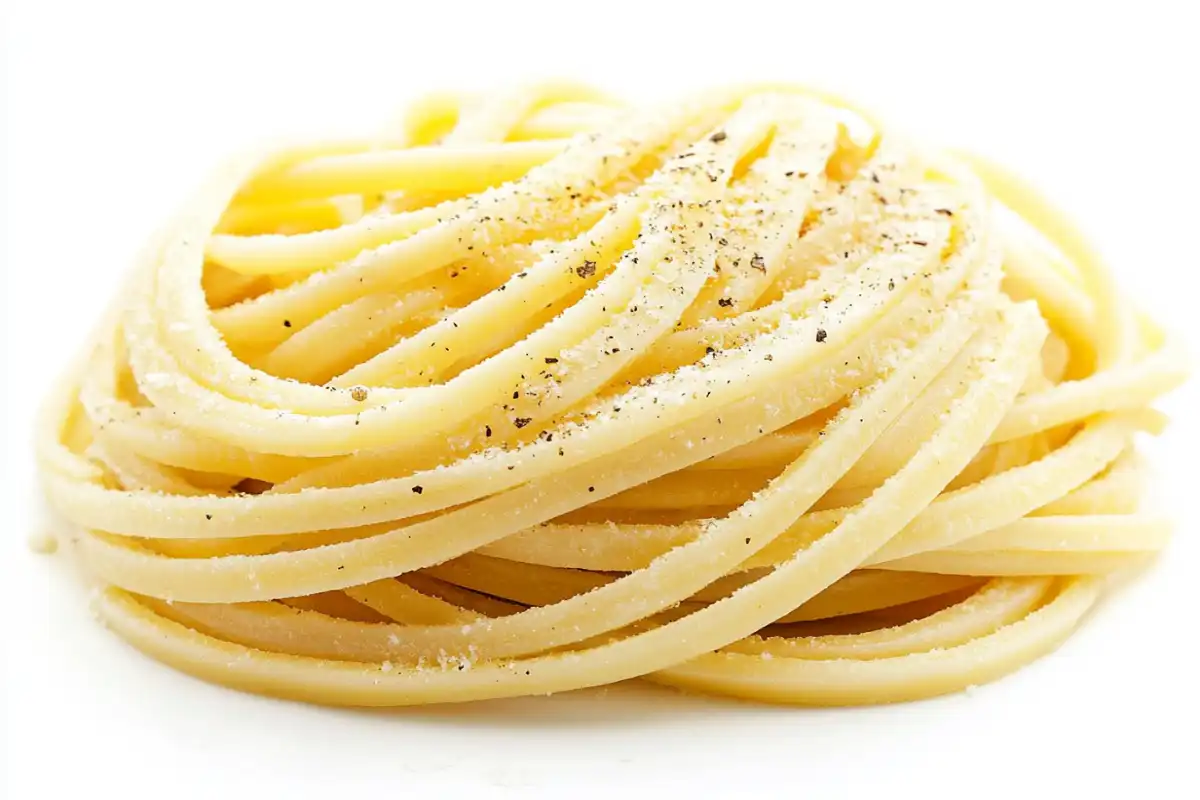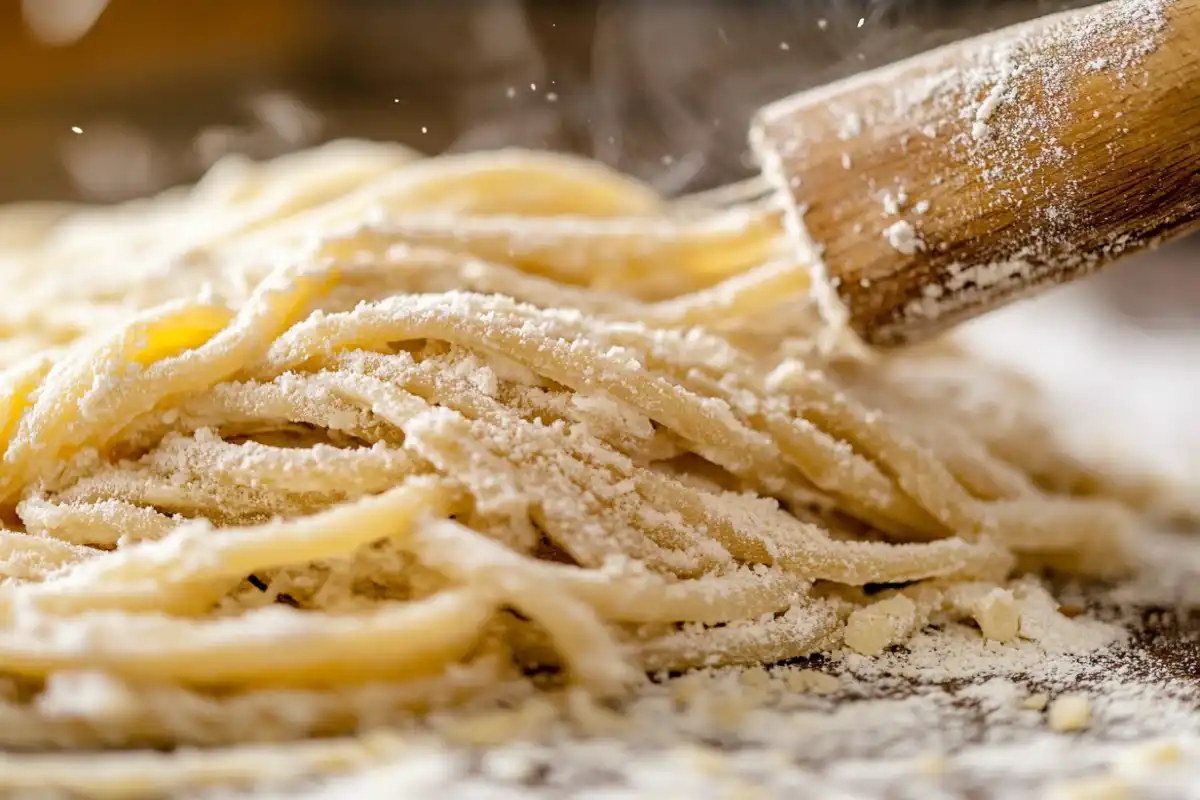Introduction to Cacio e Pepe
What is Cacio e Pepe?
Cacio e pepe is a traditional Roman pasta dish that celebrates simplicity, yet delivers extraordinary flavor. It features just three main ingredients: pasta, Pecorino Romano cheese, and black pepper. Despite its basic ingredients, it is highly regarded for its rich flavor and creamy texture. This dish holds significant cultural importance in Roman cuisine, embodying the essence of Italian cooking—minimalist yet incredibly satisfying.
The beauty of cacio e pepe lies in its ability to transform humble ingredients into a memorable dining experience. The creamy consistency of the sauce, made from emulsifying grated Pecorino Romano with starchy pasta water, coats each strand of pasta perfectly. The freshly cracked black pepper adds a punch of heat, balancing out the salty, sharp notes of the cheese.
This dish is a quintessential representation of Roman culinary traditions, where the focus is on the quality of ingredients and precise techniques rather than elaborate preparations. The magic of cacio e pepe comes from getting the details right—using the right amount of pasta water, perfectly timing the cooking, and combining the ingredients in such a way that a smooth, velvety sauce is formed.
Whether enjoyed in a cozy Roman trattoria or recreated in home kitchens around the world, cacio e pepe remains a beloved staple that resonates with food lovers due to its elegant simplicity and deep connection to the history of Italian cuisine.

Historical Background of Cacio e Pepe
The origins of cacio e pepe can be traced back to the Italian countryside, particularly Rome. Historically, it was a staple for shepherds who needed simple, non-perishable ingredients while traveling. Pecorino Romano, a hard cheese that could easily be carried, and dried pasta were perfect for this purpose. The dish provided nourishment and comfort, making it ideal for shepherds who spent long periods in the fields.
Over time, cacio e pepe evolved from a shepherd’s meal to a beloved Roman culinary staple, enjoyed by locals and tourists alike. Its transformation into a culinary icon is a testament to the timeless appeal of simple yet satisfying dishes. Learn more about the history of Italian cuisine to understand how dishes like cacio e pepe became popular.
In Roman households, cacio e pepe has long been a go-to dish for its ease of preparation and delightful flavors. It is said that the dish was popularized by Roman workers and travelers who appreciated its portability and the minimal equipment needed to cook it. By just carrying pasta, Pecorino Romano, and black pepper, they could whip up a comforting meal anywhere.
The history of cacio e pepe reflects the Italian philosophy of using high-quality, local ingredients to create satisfying meals without excessive complexity. This dish is now emblematic of Rome’s culinary culture and remains an enduring favorite in Roman restaurants. Cacio e pepe embodies the idea that less is more—a concept that resonates deeply with the ethos of traditional Italian cooking.
Ingredients and Their Importance
- Pecorino Romano Cheese
- Pecorino Romano is essential for cacio e pepe. It has a sharp, salty flavor that contrasts beautifully with the black pepper. Its texture is ideal for creating a creamy sauce when mixed with pasta water. Pecorino Romano is one of Italy’s oldest cheeses, with origins dating back to ancient Rome, and its unique characteristics make it the perfect cheese for this dish.
- The cheese is aged for a period that gives it a firm texture, allowing it to be grated finely. When mixed with hot, starchy pasta water, Pecorino Romano melts into a creamy, rich sauce that coats the pasta perfectly. The cheese’s sharpness adds a distinct flavor that elevates the simplicity of cacio e pepe, making it a star ingredient.
- Black Pepper
- Freshly cracked black pepper plays a crucial role, giving the dish its signature bite. The pepper balances the saltiness of the cheese, creating a depth of flavor from minimal ingredients. The process of toasting the pepper in the pan before adding the pasta intensifies its flavor, releasing aromatic oils that infuse the entire dish.
- The use of a generous amount of black pepper is what sets cacio e pepe apart from other cheese-based pasta dishes. The heat from the pepper adds complexity and enhances the overall flavor profile, making each bite dynamic and satisfying.
- Pasta
- The type of pasta used can make or break this dish. Tonnarelli or spaghetti are ideal choices, as their shape and texture help hold the sauce effectively. The pasta water, rich in starch, helps emulsify the cheese into a creamy sauce that coats each strand perfectly. Proper pasta cooking techniques are crucial to achieving the best texture for this dish.
- The key to a successful cacio e pepe lies in the starchy pasta water. As the pasta cooks, it releases starch into the water, which is later used to create the creamy emulsion that binds the Pecorino Romano to the pasta. This is why it is essential to reserve enough pasta water before draining the pasta.

What Makes Cacio e Pepe Special?
- Simplicity of Ingredients
- The dish stands out because it uses only three main ingredients, yet achieves a complex taste. The simplicity of cacio e pepe is deceptive—although it contains few ingredients, the result is a rich, layered flavor that is deeply satisfying. The focus on just pasta, cheese, and black pepper allows each component to shine, highlighting the importance of quality ingredients.
- Complex Flavor from Simple Elements
- The combination of Pecorino Romano and black pepper creates a rich, creamy consistency with layers of flavor that feel indulgent. The magic of cacio e pepe lies in how the flavors meld together—the saltiness of the cheese, the heat of the pepper, and the comforting texture of the pasta create a perfect balance.
- The process of creating the sauce is what truly makes cacio e pepe special. The cheese must be emulsified with the hot pasta water to create a smooth, creamy sauce that clings to the pasta. This requires skill and attention, as improper technique can result in a lumpy or greasy sauce. The alchemy of turning just a few ingredients into a luxurious sauce is what gives cacio e pepe its special character.
- Technique Over Ingredients
- The magic lies in the technique: emulsifying the cheese and pasta water without clumping. Mastering this technique is key to making a perfect cacio e pepe. Unlike other pasta dishes that may rely on a variety of ingredients to achieve their complexity, cacio e pepe is all about getting the method right.
- The key is to use hot, starchy pasta water to create the emulsion. Adding the cheese too quickly or at the wrong temperature can cause it to seize up, resulting in a grainy texture. The technique requires patience and precision, as well as an understanding of how heat, fat, and starch interact. When done correctly, the result is a silky, smooth sauce that perfectly coats each strand of pasta.
Comparison to Other Classic Italian Dishes
Cacio e pepe is often compared to other Roman classics like carbonara and amatriciana. Unlike these dishes, cacio e pepe does not rely on additional ingredients like eggs or cured pork, making it distinct in its simplicity. While carbonara has a creamy texture due to eggs, cacio e pepe achieves creaminess solely from Pecorino Romano and pasta water, showcasing how powerful minimalism can be.
- Carbonara vs. Cacio e Pepe
- Carbonara includes guanciale (cured pork cheek) and eggs, giving it a richer, more indulgent flavor. In contrast, cacio e pepe relies entirely on Pecorino Romano and black pepper, which makes it lighter but no less flavorful. The absence of meat and eggs in cacio e pepe allows the sharpness of the cheese and the spiciness of the pepper to take center stage.
- Amatriciana vs. Cacio e Pepe
- Amatriciana features guanciale and tomato sauce, adding a tangy sweetness to the dish. Cacio e pepe, on the other hand, remains purely focused on the savory elements of cheese and pepper. This makes cacio e pepe a more straightforward dish, yet it still delivers a deeply satisfying flavor experience.
How to Make Authentic Cacio e Pepe
- Step-by-Step Recipe
- Begin by cooking pasta in salted water until al dente. Reserve some pasta water before draining. The starchy pasta water is crucial for creating the creamy sauce.
- In a pan, toast freshly cracked black pepper to release its aroma. This step is key to enhancing the pepper’s flavor and ensuring that it infuses the entire dish.
- Add the pasta water and cooked pasta to the pan. The water should be hot but not boiling, as this helps to emulsify the Pecorino Romano without causing it to clump.
- Gradually mix in grated Pecorino Romano, stirring constantly to create a creamy sauce. The cheese must be added slowly, and continuous stirring is essential to prevent clumping and achieve a smooth, velvety consistency.
- Tips for Success
- To prevent the cheese from clumping, use hot, starchy pasta water and add it gradually while mixing. The key is to keep the mixture moving, allowing the cheese to melt evenly and combine with the water to form an emulsion.
- Using freshly grated Pecorino Romano is important, as pre-grated cheese often contains anti-caking agents that can interfere with the emulsification process.
- Common Mistakes to Avoid
- Overheating the cheese or not using enough pasta water can result in a lumpy, grainy sauce. It is important to keep the heat low and to add enough starchy water to create a smooth emulsion. Adding the cheese too quickly or using water that is too hot can cause the sauce to break.
The Cultural Significance of Cacio e Pepe
Cultural Importance in Rome
Cacio e pepe is more than just a dish—it is a symbol of Roman culture. It is often served at family gatherings and remains a popular choice in local trattorias. For tourists visiting Rome, it represents an authentic taste of traditional Italian cuisine, embodying the simplicity and boldness of Roman flavors.
In Rome, cacio e pepe is synonymous with comfort food. It is a dish that brings people together, whether at home or in a bustling trattoria. The simplicity of the dish reflects the no-nonsense attitude of Roman culture, where the focus is on enjoying life and savoring good food without unnecessary embellishments.
The popularity of cacio e pepe has also spread beyond Rome, becoming a symbol of Italian culinary excellence around the world. Many restaurants in Italy and abroad feature cacio e pepe on their menus as a way to offer diners a taste of authentic Roman cuisine. The dish’s straightforward nature makes it accessible, yet its rich flavor keeps people coming back for more.
The cultural significance of cacio e pepe is also evident in its presence at Roman festivals and celebrations. It is often served during special occasions, showcasing its role as a beloved part of the city’s culinary heritage. The dish’s simplicity and depth of flavor make it a fitting representation of Roman culture—uncomplicated, bold, and deeply satisfying.

Modern Interpretations and Variations
- Innovative Twists on the Classic Recipe
- Some modern versions include additions like truffle or lemon zest, adding a new layer of flavor. The addition of truffle brings an earthy richness that complements the sharpness of Pecorino Romano, while lemon zest adds a refreshing brightness that cuts through the dish’s richness.
- Other variations incorporate ingredients such as garlic, butter, or even mushrooms to create a different flavor profile. These additions can enhance the dish without straying too far from its traditional roots, allowing chefs to put their own stamp on cacio e pepe.
- Restaurant and Chef Interpretations
- Many chefs worldwide have put their own spin on cacio e pepe, creating unique versions while respecting the dish’s origins. High-end restaurants may use artisanal Pecorino Romano and freshly milled black pepper to elevate the dish, while others experiment with different types of pasta to add texture and visual appeal.
- Some chefs have even deconstructed cacio e pepe, serving it in innovative ways such as as a stuffed pasta or as a sauce for other dishes. These interpretations keep the essence of cacio e pepe alive while pushing the boundaries of how it can be enjoyed.
- Vegan and Dairy-Free Versions
- Vegan adaptations use alternatives like nutritional yeast and cashew cream to replicate the taste and texture of Pecorino Romano, making the dish accessible to those with dietary restrictions. Nutritional yeast provides a cheesy flavor, while cashew cream offers the creamy consistency needed to coat the pasta.
- Dairy-free versions may also use plant-based cheeses made from almonds or soy to mimic the sharpness of Pecorino Romano. These adaptations allow more people to enjoy cacio e pepe without sacrificing the dish’s iconic flavor profile.
Where to Find the Best Cacio e Pepe
- Famous Restaurants in Rome
- Some of the best cacio e pepe can be found in iconic Roman restaurants such as Da Enzo al 29 and Felice a Testaccio, known for their authentic take on this classic dish. These establishments have perfected the art of cacio e pepe, using traditional methods and high-quality ingredients to create a dish that is both simple and sublime.
- Felice a Testaccio, in particular, is famous for its tableside preparation of cacio e pepe, where servers mix the pasta, cheese, and pepper in front of guests, ensuring the perfect consistency and providing an interactive dining experience.
- Global Popularity
- The dish has also become popular worldwide, with many international restaurants offering their own renditions, often adding a modern twist while staying true to the core ingredients. From New York to Tokyo, cacio e pepe has found its way onto menus, often adapted to suit local tastes while maintaining its essence.
- In many upscale Italian restaurants outside of Italy, cacio e pepe is presented as a signature dish that showcases the chef’s skill in balancing flavors and textures with minimal ingredients. The dish’s simplicity makes it a benchmark for technique, and chefs take pride in creating a perfect version.
Frequently Asked Questions
- Is cacio e pepe difficult to make at home?
- No, it is simple but requires attention to detail, particularly in emulsifying the cheese and pasta water. The key is to use the right technique to create a smooth sauce. With practice, anyone can master this dish.
- What type of cheese is used in cacio e pepe?
- Pecorino Romano is the traditional cheese used for its sharp, salty flavor. It is important to use freshly grated Pecorino Romano for the best results, as the pre-grated versions may not melt as smoothly.
- What pasta is best for cacio e pepe?
- Tonnarelli or spaghetti are ideal as they hold the sauce well. Tonnarelli is slightly thicker and has a rougher texture, which helps the sauce cling better. If unavailable, high-quality spaghetti is a great alternative.
- How is cacio e pepe different from carbonara?
- Carbonara includes eggs and guanciale, whereas cacio e pepe relies solely on cheese and black pepper. The absence of eggs and meat makes cacio e pepe a lighter, yet equally flavorful, option.
Conclusion
Cacio e pepe is a celebration of simplicity, relying on just a few high-quality ingredients and precise technique to create something truly special. Its cultural significance in Rome, combined with its unique flavor profile, makes it a must-try for anyone interested in authentic Italian cuisine. Whether enjoyed in a Roman trattoria or made at home, cacio e pepe continues to capture the hearts of pasta lovers everywhere.
The dish’s enduring popularity is a testament to the power of simplicity in cooking. In a world where culinary trends often lean towards complexity and fusion, cacio e pepe stands as a reminder that the best dishes are often those that let quality ingredients speak for themselves. Its rich history, cultural significance, and unforgettable flavor make cacio e pepe not just a dish, but a symbol of the beauty of Italian cuisine.
